【第七十四回目】
梅園:浅草のお楽しみ「あわぜんざい」
Umezono: Enjoying Asakusa Awazenzai
Umezono: Enjoying Asakusa Awazenzai
しっかりと守るということと、時代に合わせて変化を続けていく、ということが大事だと思っています。8割は守り、2割は変化させる。
I think it’s important to make sure we preserve the same things that all the previous owners preserved, and to keep changing with the times. We try to preserve 80 percent and change 20 percent.
| セインさん、今日は浅草寺の参道に店を構える甘味処「梅園」です。幕末の安政元年(1854)に、浅草寺の別院・梅園院の庭先を借りて始めた茶屋が始まりだそうで、浅草の甘味処といえば、この店! セインさんは、初めてですか? Today we’ll be visiting a sweets shop on the road to Sensoji Temple called Umezono. It began as a tea house in the Umezono Garden owned by Sensoji Temple. It’s the number one sweets shop in Asakusa! Thayne-san, is today your first time here? *Sensoji Temple: https://en.wikipedia.org/wiki/Sens%C5%8D-ji |
|
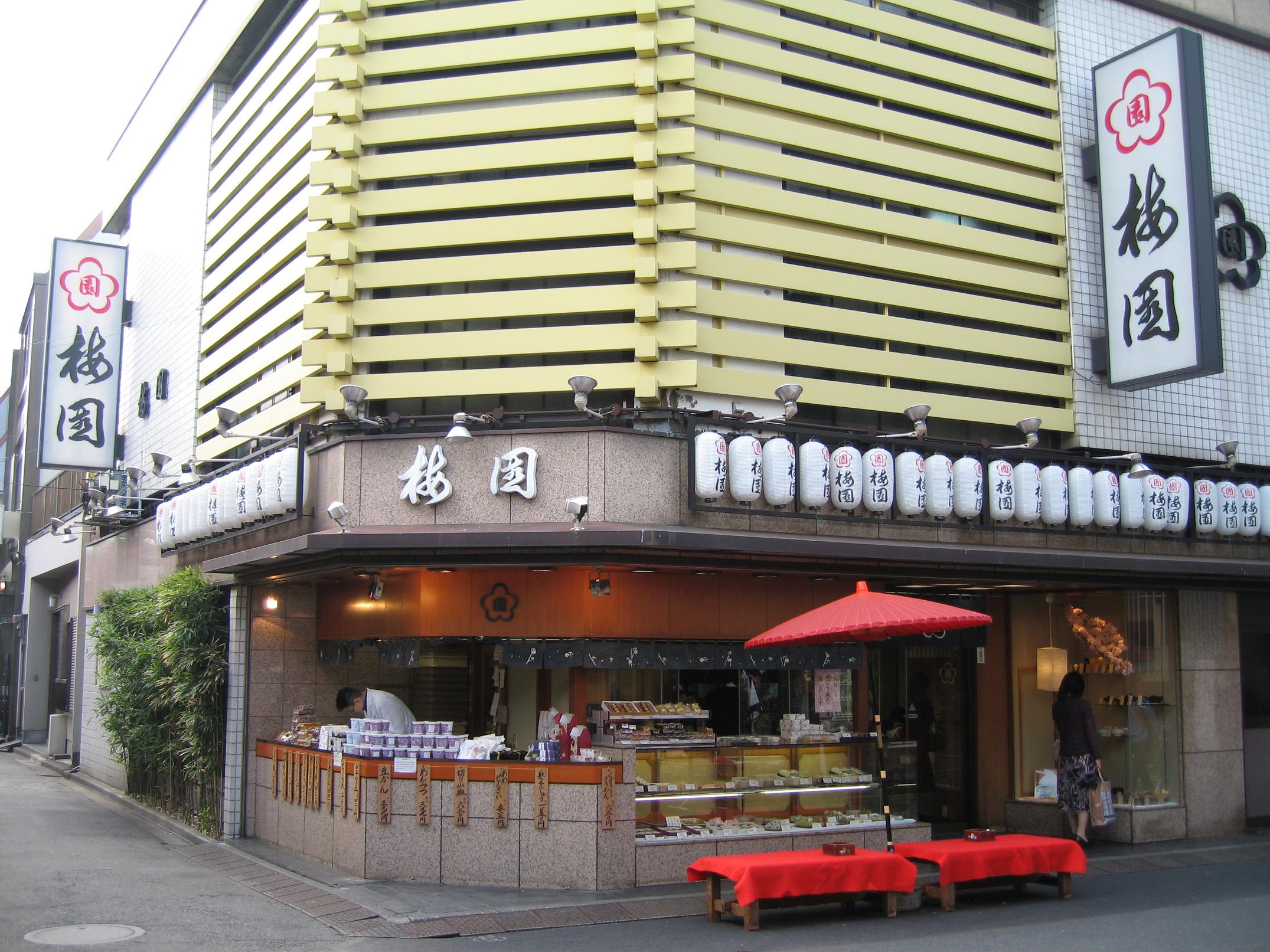 梅園の浅草本店 梅園の浅草本店Umezono’s main store in Asakusa |
|
| かなり前ですけれど、一度来たことがあります。観光客でいっぱいで、にぎやかでした。あの時は、あんみつを食べたんだったかなあ。今日も楽しみです。 A long time ago, I did come here once. There were a lot of sightseers, so it was lively. I think I ate anmitsu. I’m looking forward to my second visit today. |
|
| (清水) | ようこそ、セインさん、コンシェルジュさん!「梅園」の清水貴司です。 Shimizu: Welcome! I’m Takashi Shimizu, the owner of Umezono. |
| こんにちは、清水さん。 Hello, Shimizu-san. |
|
| 早速なのですが、お店の隣のビルの前に置かれているこの大きな水がめは、梅園さんのものですか? I need to ask, does the big water jar in front of the building next door belong to Umezono? |
|
| (清水) | はい。昭和20年(1945)3月の東京大空襲で、焼け残った水がめです。東京大空襲では浅草も一帯が火の海になり、当店も全焼しました。焼け跡に、これだけがポツンと残っていたそうです。 Shimizu: Yes. It’s a water jar that survived the bombing of Tokyo in March 1945. All of Asakusa became a sea of flames, and the store was completely burned down. The jar was just sitting by itself in the rubble. |
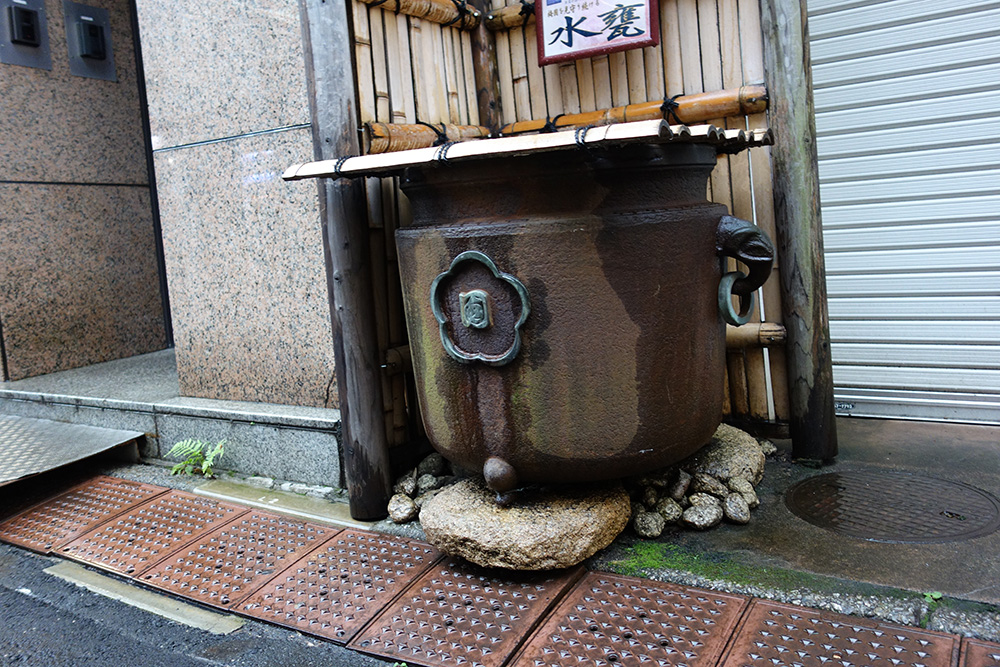 空襲で焼け残った水がめ 空襲で焼け残った水がめThe jar that survived the bombing |
|
| 老舗はどこも大変な時代も生き抜いて、今があるんですね。「梅園」は、清水さんで何代目ですか? It seems like most long-established stores have gone through a lot of difficult times. How many generations of owners have there been including you? |
|
| (清水) | :7代目です。父が3年前に亡くなって跡を継いだので、まだまだ新米ですが。 Shimizu: I’m the seventh. I inherited the store when my father passed away two years ago, so I’m still new to the business. |
| 若くして跡を継ぐことになって、悩んだり、苦労したりしたことはないですか? Was there anything that was challenging or difficult for you because you took over the business at a young age? |
|
| (清水) | 父が亡くなって、僕は30歳で社長になったのですが、ここで生まれ育って大学生からは製造の手伝いもしていましたし、23歳からは正式に社員として入っていましたので、特に困るということはありませんでした。社員のみんなもしっかり支えてくれていますし。 Shimizu: When my father passed away and I took his place, I was 33, but I was born and raised here. I’ve been helping with production since I was in junior high, and I’ve been a full time employee since I was 18, so there was nothing in particular that I had difficulty with. All the employees gave me their full support too. |
| すでにキャリアがあっただけでなく、会社全体が温かな雰囲気なのですね。 代々、言い伝えられているお店のポリシーなどはありますか? It’s not just a jobーthe whole company has a warm atmosphere. Does your shop have some kind of policy or mission statement that has been passed down through the generations? |
|
| (清水) | 文字にして伝わっているものなどは特にありませんが、やはり代々が守り続けてきたものを、しっかりと守るということと、時代に合わせて変化を続けていく、ということだと思います。8割は守り、2割は変化させる。 Shimizu: There’s not really anything that’s written down, but I think it’s important to make sure we preserve the same things that all the previous owners preserved, and to keep changing with the times. We try to preserve 80 percent and change 20 percent. |
| 8割は守る? Preserve 80 percent? |
|
| (清水) | はい。梅園の名物は初代が創案した「あわぜんざい」ですが、まずはこの味をしっかり守り伝えることを大事にしています。 もちろん小豆を始めとする原材料は、品種改良されていますから昔と同じものではありませんし、年によっても出来が変わりますから、初代とまったく同じものは作れませんし、去年と今年でも違うかもしれません。ですが、その時々で、一番おいしい味、梅園の味を創ろうという姿勢はブレません。 ですから、お客様から「懐かしい味がした。子どもの頃に親に連れられて来たことを思い出した」といった声をいただくと、とても嬉しいんです。 Shimizu: Yes. Umezono’s most famous product is the awazenzai. It’s a pastry invented by the first owner, so the most important thing is to make sure to preserve the original flavor. Of course, the azuki beans and other ingredients are not the same as in the past because of improvements in cultivation, so they turn out differently from year to year. We can’t make exactly the same things as the founder, and even this year’s product may be different from last year’s. But Umezono always prides itself in providing the best possible flavor at the time, and that’s the “Umezono flavor.” |
| よくわかります! そして、そのお客様も世代交代していくんですよね。 That makes sense! I guess you also your get a lot of generational customers, people who came with their parents or grandparents. |
|
| (清水) | そうなんです。親子3代でおいでになるお客様もいらっしゃいます。 Shimizu: That’s right. We have customers now who say they remember coming here with their grandparents. |
| そして一方では、2割は変化する。 You said you change 20 percent… |
|
| (清水) | はい。梅園は創業して160年以上になりますが、現代社会は、昔とは比べものにならないほどのスピードで変化し続けています。その変化をつかんで挑戦していかなければ、次の時代に店は残りません。 Shimizu: Yes. It’s been 160 years since Umezono was established, but times are changing faster than ever. If we don’t innovate and keep up with the times, the shop won’t survive. |
| どんなことに挑戦しているんですか? What kind of new things are you trying to accomplish? |
|
| (清水) | 一つは、新しい商品づくりです。梅園をもっと知っていただくために、いろいろなお客様にお菓子が届くようにと考えて開発しています。たとえば、最近、とても人気があるのが「子とら」。小さなどらやきなんです。 Shimizu: One thing is making new products. I want more people to know about Umezono, so I’m always thinking new products for our customers. One thing that has been really popular recently is Kotora. It’s a mini-sized dorayaki. *dorayaki: https://en.wikipedia.org/wiki/Dorayaki |
| ああ、これはいいですね。ちょっと甘いものが欲しい時に、ぴったりの大きさですね。手土産にも喜ばれそうです! Wow, this is great! It’s just the right size for when you want just a bite. It looks like it would make a great gift too! |
|
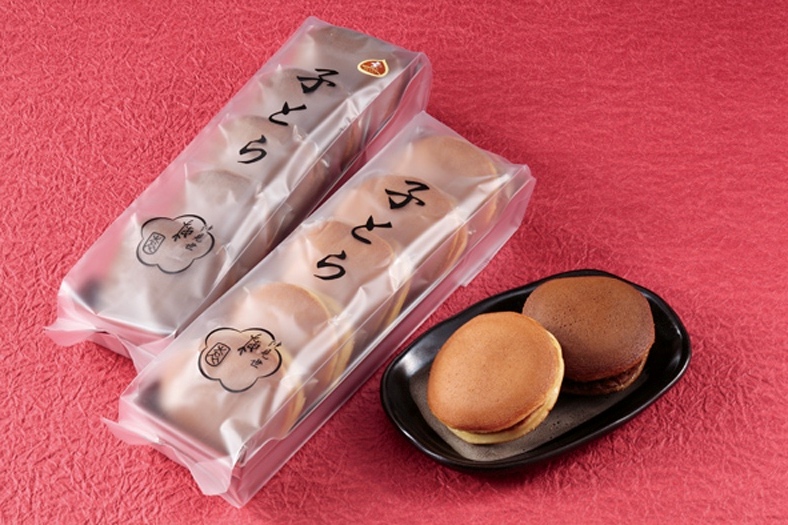 子とら 子とらKotora |
|
| (清水) | 羽田空港の国際線旅客ターミナル「江戸小路」にあるイートインのある店のオープン時には「お寿司」の形をした上生菓子も作りました。 Shimizu: When we opened an eat-in restaurant in the Edo Market at the international terminal of Haneda Airport, we made sushi-shaped sweets. *Edo Market: http://www.hellojapan.asia/en/travel-guide/edo-market-place.html |
| 握り寿司のお菓子?! マグロとか玉子、イカの寿司のかたちですか? Sushi-shaped sweets?! Tuna and sea bream? |
|
| (清水) | はい。外国人の観光客にも楽しんでいただけるかなと思って作ったんですが、日本人のお客様にも好評でした。 Shimizu: Yes. I thought that foreign tourists would enjoy them, but they’ve actually been really popular with Japanese customers as well. |
| 空港で、出国前のお土産にいいですね! It makes a good gift you can buy at the airport before you leave! |
|
| (清水) | もう一つの挑戦は、新しい場所の開拓です。浅草寺に参拝されて、帰りに本店に立ち寄ってくださるお客さまを大切にしつつも、浅草にいらっしゃらない方にも、うちのお菓子を食べていただきたい。そう思ったら、私たちが出ていかなければなりません。これまでも百貨店や駅ビルなどへの出店はしてきましたが、最近は郊外のショッピングモールなどにも店を出しています。 Shimizu: Another thing we’re trying is opening shops in other locations. We really value the customers who drop by our shop on the way back from visiting Sensoji Temple, but I also want people who aren’t in Asakusa to try our sweets. I realised that we have to get out there. Up until now, we’ve opened shops in big department stores and train stations, but we’ve recently also been opening shops in shopping malls outside of the main cities. |
| そこで、若いファミリー層など、新しいファンをつかもうというわけですね。 梅園がアピールしたい味の特徴って、ずばり、なんですか? That way, you can get new fans from different demographics, such as young families. In a nutshell, what is there about Umezono that you would you like to promote the most? |
|
| (清水) | 餡(あん)のおいしさです。素直に「ああ、おいしいな」という言葉がでるような。セインさん、コンシェルジュさん。そろそろ話は終わりにして、「あわぜんざい」を召し上がってください。 Shimizu: How delicious the azuki bean paste is. You just have to say, “Wow, this is good!” Maybe it’s time to finish up the conversation, and start the tasting. Maybe you should try the awazenzai. |
| ありがとうございます。では、いただきまーす。 Thank you. Itadakimasu!. |
|
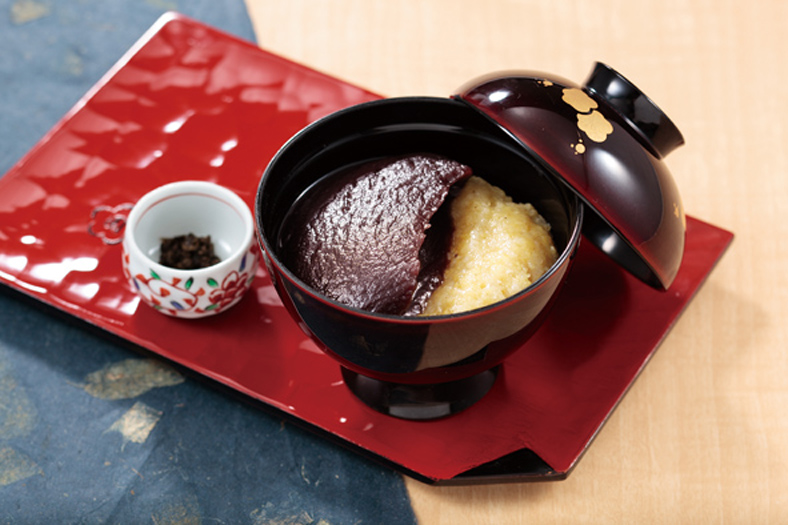 あわぜんざい あわぜんざいAwazenzai |
|
| なるほど。餡、おいしいですねー。そして、この粒粒のお餅が粟(あわ)ですか? 食感が独特で、なめらかな餡とよく合います。 I see. The azuki bean paste really is delicious. Is this rough textured mochi made of foxtail millet? |
|
| (清水) | 実は、当店の「あわぜんざい」に入っている、もちもちしたものは、粟ではなく、「餅きび」を半搗きしたものなんです。米の餅と違って、独特の歯ごたえと粘り、そして渋みがあるのが特徴です。 餅きびと、じっくり炊いた漉し餡を一緒に召し上がっていただく――これが、梅園が伝えてきた味です。 そうそう。先ほど「変えない」話をしましたが、餅きびを蒸しているヒノキの蒸籠(せいろ)や、餡を煉る銅鍋などの道具も、昔ながらのものです。 Shimizu: Actually, the soft stuff in our awazenzai isn’t foxtail millet, like other awazensai. It’s half-polished common millet. It’s different than rice cake It has a unique stickiness and texture when you bite into it, and a slightly astringent taste. We serve common millet and slow cooked bean paste togetherーthis is the flavor that has been handed down by Umezono. We talked about “preserving” a moment ago, but the tools like the cypress steaming baskets that we steam the millet in and the pot we stew the beans in have been used for generations. |
| ヒノキの蒸籠をステンレス製にすると、もっと便利になったりするとか、すべてオートメーション化するとたくさん作れて儲かる、というようなことを考えることはないですか? Do you ever wonder if it would be easier to use stainless steel pans , or if you could make a lot of money by automating everything and increasing production? |
|
| (清水) | たとえばヒノキの蒸籠をステンレスにすると、味が変わってしまうんです。だから変えられないですし、変えようとも思っていません。 Shimizu: If we change the steaming baskets to stainless steel, the flavor will change. So we can’t change them, we don’t even think about it. |
| そこが「守り続ける8割!」、の部分ですね。よくわかりました。 今日は、ありがとうございました。 You’re talking about preserving the 80 percent. I get it. Thanks for having us today. |
|
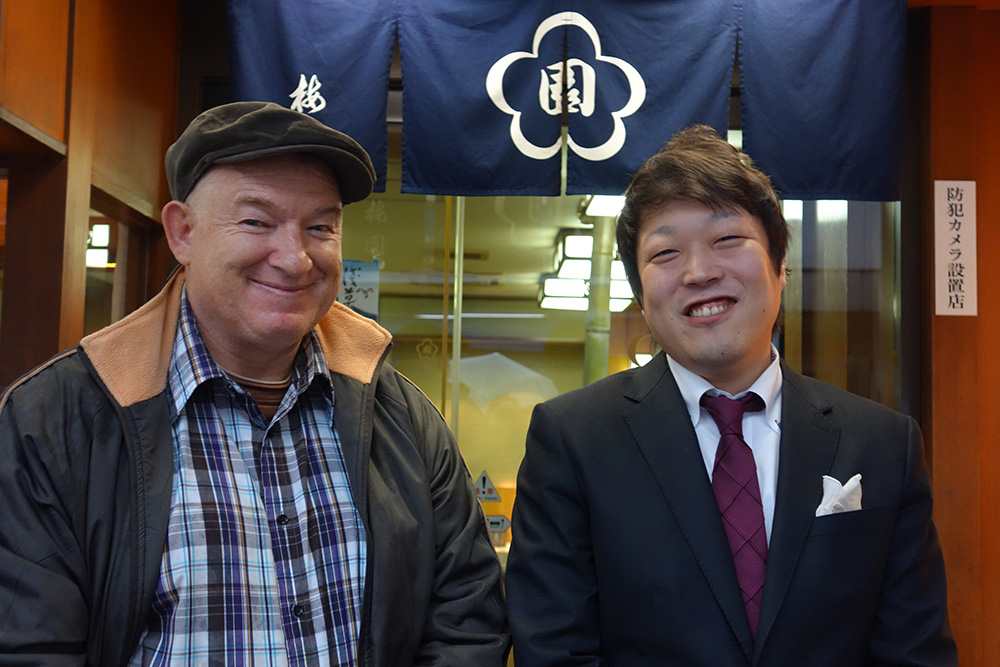 |
|
| 梅園ホームページはコチラ | |
| (文)太田美代 (英訳)デイビッド・A・セイン |
 1959年、米国生まれ。証券会社勤務を経て来日し、翻訳・通訳など多岐にわたって活躍。豊富な教授経験を生かし、数多くの英語関係書籍を執筆。近著に『日本人のチョットへんな英語』(アスコム)、『超入門シャドーイング』(主婦の友社)、日本人が使いすぎる英語(PHP文庫)など多数。 下町の魅力に魅了され、自身が代表を務める英語関連のコンテンツ会社のエートゥーゼットのオフィスを根津に構えている。英会話本の執筆をしながら、東京・文京区根津と春日にあるエートゥーゼット英語学校の校長も務める。 http://www.smartenglish.co.jp/
1959年、米国生まれ。証券会社勤務を経て来日し、翻訳・通訳など多岐にわたって活躍。豊富な教授経験を生かし、数多くの英語関係書籍を執筆。近著に『日本人のチョットへんな英語』(アスコム)、『超入門シャドーイング』(主婦の友社)、日本人が使いすぎる英語(PHP文庫)など多数。 下町の魅力に魅了され、自身が代表を務める英語関連のコンテンツ会社のエートゥーゼットのオフィスを根津に構えている。英会話本の執筆をしながら、東京・文京区根津と春日にあるエートゥーゼット英語学校の校長も務める。 http://www.smartenglish.co.jp/







